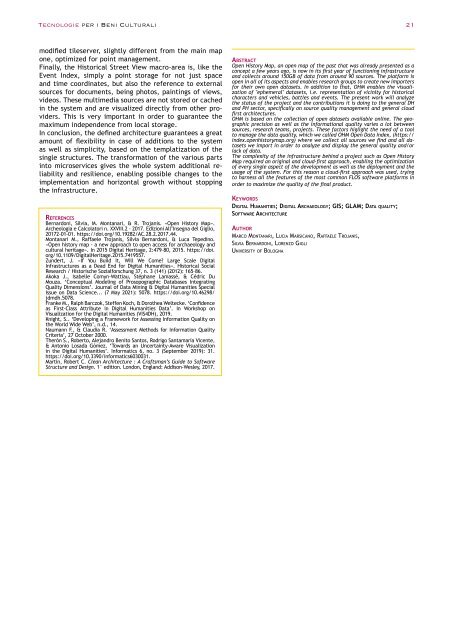Archeomatica 2 2022
Tecnologie per i Beni Culturali
Tecnologie per i Beni Culturali
You also want an ePaper? Increase the reach of your titles
YUMPU automatically turns print PDFs into web optimized ePapers that Google loves.
Tecnologie per i Beni Culturali 21<br />
modified tileserver, slightly different from the main map<br />
one, optimized for point management.<br />
Finally, the Historical Street View macro-area is, like the<br />
Event Index, simply a point storage for not just space<br />
and time coordinates, but also the reference to external<br />
sources for documents, being photos, paintings of views,<br />
videos. These multimedia sources are not stored or cached<br />
in the system and are visualized directly from other providers.<br />
This is very important in order to guarantee the<br />
maximum independence from local storage.<br />
In conclusion, the defined architecture guarantees a great<br />
amount of flexibility in case of additions to the system<br />
as well as simplicity, based on the templatization of the<br />
single structures. The transformation of the various parts<br />
into microservices gives the whole system additional reliability<br />
and resilience, enabling possible changes to the<br />
implementation and horizontal growth without stopping<br />
the infrastructure.<br />
References<br />
Bernardoni, Silvia, M. Montanari, & R. Trojanis. «Open History Map».<br />
Archeologia e Calcolatori n. XXVIII.2 - 2017. Edizioni All’Insegna del Giglio,<br />
20172-01-01. https://doi.org/10.19282/AC.28.2.2017.44.<br />
Montanari M., Raffaele Trojanis, Silvia Bernardoni, & Luca Tepedino.<br />
«Open history map - a new approach to open access for archaeology and<br />
cultural heritage». In 2015 Digital Heritage, 2:479–80, 2015. https://doi.<br />
org/10.1109/DigitalHeritage.2015.7419557.<br />
Zundert, J. «If You Build It, Will We Come? Large Scale Digital<br />
Infrastructures as a Dead End for Digital Humanities». Historical Social<br />
Research / Historische Sozialforschung 37, n. 3 (141) (2012): 165–86.<br />
Akoka J., Isabelle Comyn-Wattiau, Stéphane Lamassé, & Cédric Du<br />
Mouza. ‘Conceptual Modeling of Prosopographic Databases Integrating<br />
Quality Dimensions’. Journal of Data Mining & Digital Humanities Special<br />
Issue on Data Science... (7 May 2021): 5078. https://doi.org/10.46298/<br />
jdmdh.5078.<br />
Franke M., Ralph Barczok, Steffen Koch, & Dorothea Weltecke. ‘Confidence<br />
as First-Class Attribute in Digital Humanities Data’. In Workshop on<br />
Visualization for the Digital Humanities (VIS4DH), 2019.<br />
Knight, S.. ‘Developing a Framework for Assessing Information Quality on<br />
the World Wide Web’, n.d., 14.<br />
Naumann F., & Claudia R. ‘Assessment Methods for Information Quality<br />
Criteria’, 27 October 2000.<br />
Therón S., Roberto, Alejandro Benito Santos, Rodrigo Santamaría Vicente,<br />
& Antonio Losada Gómez. ‘Towards an Uncertainty-Aware Visualization<br />
in the Digital Humanities’. Informatics 6, no. 3 (September 2019): 31.<br />
https://doi.org/10.3390/informatics6030031.<br />
Martin, Robert C. Clean Architecture : A Craftsman’s Guide to Software<br />
Structure and Design. 1° edition. London, England: Addison-Wesley, 2017.<br />
Abstract<br />
Open History Map, an open map of the past that was already presented as a<br />
concept a few years ago, is now in its first year of functioning infrastructure<br />
and collects around 150GB of data from around 90 sources. The platform is<br />
open in all of its aspects and enables research groups to create new importers<br />
for their own open datasets. In addition to that, OHM enables the visualization<br />
of "ephemeral" datasets, i.e. representation of vicinity for historical<br />
characters and vehicles, battles and events. The present work will analyze<br />
the status of the project and the contributions it is doing to the general DH<br />
and PH sector, specifically on source quality management and general cloud<br />
first architectures.<br />
OHM is based on the collection of open datasets available online. The geographic<br />
precision as well as the informational quality varies a lot between<br />
sources, research teams, projects. These factors higlight the need of a tool<br />
to manage the data quality, which we called OHM Open Data Index, (https://<br />
index.openhistorymap.org) where we collect all sources we find and all datasets<br />
we import in order to analyze and display the general quality and/or<br />
lack of data.<br />
The complexity of the infrastructure behind a project such as Open History<br />
Map required an original and cloud-first approach, enabling the optimization<br />
of every single aspect of the development as well as the deployment and the<br />
usage of the system. For this reason a cloud-first approach was used, trying<br />
to harness all the features of the most common FLOS software platforms in<br />
order to maximize the quality of the final product.<br />
Keywords<br />
Digital Humanities; Digital Archaeology; GIS; GLAM; Data quality;<br />
Software Architecture<br />
Author<br />
Marco Montanari, Lucia Marsicano, Raffaele Trojanis,<br />
Silvia Bernardoni, Lorenzo Gigli<br />
University of Bologna


















